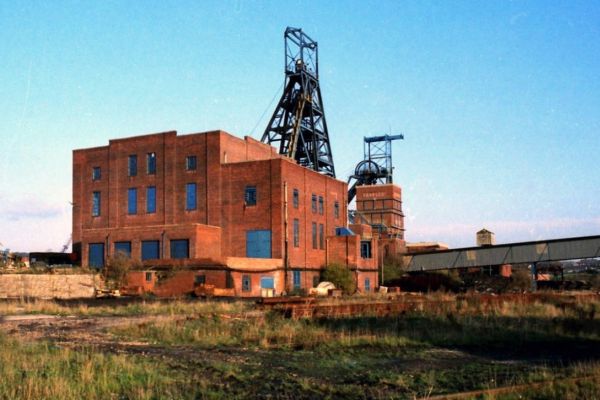
Barnburgh Main Colliery
Copyright © L Hirst and used with his kind permission
The Manvers Main Collieries Ltd sank Barnburgh as shaft numbers 5 and 6 of the Manvers complex. As well as direct link to the L.M.S.R’s Dearne Valley Railway, a 3.5 km long mineral line ran south-west to Manvers Colliery and cokeworks had been built by 1930. The same company worked the mine until it was nationalised.
Sinking began in 1911, paused in 1912, presumably while surface plant was built, and continued from 1913 until the Thorncliffe seam was cut at a depth of 720 metres in 1915. Both shafts were brick-lined throughout. No.7 Shaft sunk was sunk to the Shafton seam in 1913 in order to provide a supply of water for the colliery.
The working history of the various seams, albeit taken from the List of Mines which is a crude guide, is instructive of the way in which seams came in and out of production as a multitude of factors affected the mine over time. These factors might include availability of capital or manpower, market conditions, government quotas, adverse geology (itself a range of factors) and heatings.
Coal getting in the Barnsley seam began in 1914 and continued until 1954. Some coal, probably from development work, was also raised from the Shafton in 1914. The following year saw the Parkgate begin producing coal. Mining was confined to the Barnsley and Parkgate during 1915 and 1916, but included the Shafton seam between 1917 and 1923. Apart from a brief revival of the Shafton workings in 1927, the Barnsley seam alone was worked from 1924 to 1928. A return to the Parkgate in 1935 saw that seam worked continuously, despite washouts, until 1964. The Shafton is shown as working in 1937 and 1940, but was never worked again. Faces in the Haigh Moor (aka Swallow Wood), at a depth of 517½ metres, worked between 1940 and 1953, but it was found to be of inferior quality. The principal development came in 1941 when the Newhill came on stream. This 1.6 metre thick seam was worked until 1984. The Thorncliffe, however, was only worked between 1941 and 1944, and from 1960 to 1962. The Meltonfield, with 1.2 metres of coal, worked from 1962 until 1989. After closure of the Parkgate in 1964, all coal came from the Meltonfield and Newhill seams.
In order to increase winding capacity, skips carrying eight tons each were installed at No.6 Shaft in 1937. They were amongst the first skips used at a British colliery, and they functioned well. 1950 an electric winder was erected at No.6 Shaft. Loco hauled 6 ton mine-cars brought coal from the Newhill faces to the shaft.
Adverse conditions led to the failure of planned revival of work in the Newhill in 1989 and, in turn, to the closure of Barnburgh on June 16th in the same year. A drift mine, planned to be driven from Barnburgh’s pit yard to work the Shafton and Cudworth seams, never began.
An explosion at the coalface on the Newhill Seam occurred on the 26th June 1957 when a large stone fell onto a power cable, damaging it and causing a flash which ignited the Methane in the atmosphere; 6 men died and 13 others were injured. The full report can be found here.
Further reading:
- NMRS Records, Gazetteer of British Collieries
- Hill, A. The South Yorkshire Coalfield: A History and Development (Stroud: Tempus, 2002)
- Hill, A. Colliery Ventilation (Matlock: Peak District Mines Historical Society Ltd, 2000)
- Hill, A. Coal: A Chronology for Britain (NMRS, British Mining No.94, 2012)
Further information:
Return to previous page
